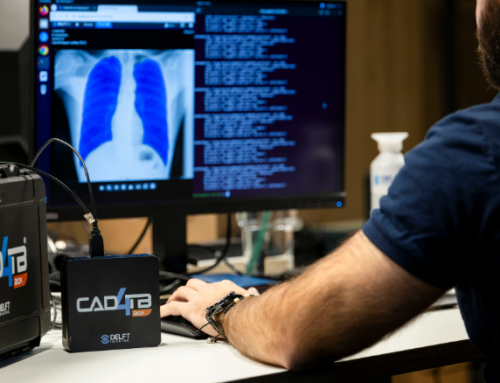As artificial intelligence (AI) becomes increasingly used in medical imaging, a question repeatedly arises: Can TB screening programs also leverage AI to detect other abnormalities on chest X-rays?
In our recent webinar, Dr. Bram van Ginneken, Professor of Medical Image Analysis at Radboud University Medical Center and co-developer of CAD4TB, shared his perspective. “Many software solutions now aim to detect all possible abnormalities in a chest X-ray, and some even generate radiology reports.” While this trend is gaining momentum in Western radiology departments, it raises a different set of considerations in the context of TB screening.
TB screening is not clinical radiology
As Dr. van Ginneken explained, “Unlike other settings, TB screening relies on single posterior-anterior chest X-rays without comparison to prior images. The primary goal is identifying TB suspicion rather than other abnormalities.” This approach, distinct from clinical radiology, limits what AI can and should be expected to detect.
Some scoring systems include non-TB findings such as cardiomegaly, but their clinical relevance is not always clear in the context of screening programs. “The findings suggest that while AI may help detect non-TB abnormalities, its sensitivity and specificity are often suboptimal, leading to potential misinterpretations and false positives.”
The limitations of AI accuracy
Dr. van Ginneken pointed to recent studies to underscore AI’s current limitations. “Our research indicates that AI trained without precise segmentation tends to perform worse than models trained with segmentation techniques, reinforcing the need for careful AI validation.” This is particularly important when software is deployed in screening settings where expert oversight may be limited.
In one study, the software’s sensitivity for cardiomegaly detection was just 55%, compared to over 90% typically achieved by trained radiologists.
Why ethical screening matters
Dr. van Ginneken reminded the audience that screening must follow basic medical ethics. “Screening should only be conducted for significant health conditions with effective treatments.” Over-diagnosis or detection of untreatable conditions can burden healthcare systems and patients alike.
He elaborated on the broader consequences of deploying AI to detect findings unrelated to TB: “Detecting untreatable conditions or over-diagnosing non-threatening abnormalities can be ethically and practically problematic.”
The case against lung cancer screening via chest X-ray
The presentation also addressed a rising interest in integrating lung cancer screening into TB programs. But Dr. van Ginneken urged caution. “Chest X-rays are not recommended for lung cancer screening due to poor sensitivity; computed tomography (CT) scans are the preferred method.”
He referred to one large-scale study: “In one large-scale study, only 0.1% of TB-screened individuals were diagnosed with lung cancer, far lower than the expected 1% in dedicated lung cancer screenings.” Worse still, “many diagnosed cases were already too advanced for treatment.”
Moreover, “Effective treatment requires advanced medical facilities, which may be unavailable in high-TB regions.”
Closing thoughts
While AI has proven to enhance efficiency in image interpretation, it must be implemented responsibly. “While AI presents promising advancements for radiology, its application in TB screening should be approached cautiously. Screening programs must prioritize treatable conditions and ensure AI tools offer clinically relevant benefits.”



